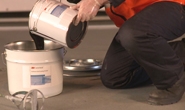
When it comes to providing long-term protection for flat roofs in commercial, public and private properties ?? whether in new build developments or as a refurbishment project ?? there are numerous factors which specifiers and users must consider. Material, installation and ancillary costs, health and safety, ease of installation, performance, longevity and environmental considerations all come into play.
The three main options available are heat-applied bituminous systems, single-ply membrane systems, and cold applied liquid roofing systems. Bituminous systems offer relatively low upfront costs and, if correctly applied and maintained, can last up to 25 years before replacement is needed.
However, their application can cause significant disruption to building occupants. Hot tar is always needed, meaning the building??s top floor cannot be used during application. Meanwhile the tar odour can permeate several floors, affecting occupants?? work or leisure activities.
Also, while material costs may be low, costs are greater elsewhere. As flammable materials are being used, a dedicated fire marshal must be supplied by the installation company. Furthermore, operatives must be trained in safe usage of heat producing equipment and given appropriate personal protective equipment (PPE). Insurance costs are also higher, due to the fire hazards.

There are other issues too, notably related to weather. The presence of rainwater means bitumen cannot be effectively applied to the felt. This means the roof can be left unsealed for a protracted period, with the possibility of leakage of rainwater and damage to the building fabric.
A popular alternative for specifiers is to use single-ply membrane systems. This flexible sheet is supplied on rolls and is welded together at the joints using either hot-air welding, solvent welding, adhesives or fasteners, negating the need for hot works and enabling a quicker and easier installation versus bituminous systems. The material offers good durability and waterproofing performance, with high levels of life expectancy when applied properly.
One potential issue however is failure at seams and joints which can allow water ingress. In particular, uneven surfaces or roof furniture, such as solar panels, chimneys and ventilation ducts, can prove difficult as to accommodate, as the membrane has to be cut and stuck down ?? with every cut potentially presenting an opportunity for water ingress in the future. In this situation, there is no proven way to effectively repair a damaged membrane, meaning the whole system may need replacement.

In addition, when these products are fixed in place with a bonding adhesive, the protection offered is only as good as the adhesive??s quality and application. Weather can again cause issues here, through uplift in windy conditions as the roof surface and membrane are forced apart before the adhesive sets. Unfortunately even the use of battens cannot be guaranteed to prevent this. It is therefore important to ensure quality materials and workmanship are employed.
A third alternative is cold-applied liquid membrane products. With these products, there are no issues of heat as the liquid is applied cold using a brush or roller and cures to form a seamless, waterproof membrane. This rapid, simple application means that in particular, waterproofing around roof obstacles is much quicker and effective than other methods.
This type of product develops an intrinsic chemical bond with the substrate, delivering optimum protection, plus many cold-applied products can be used in all weathers ?? offering great reassurance if a roof failure occurs during heavy rain. At the end of their surface life ?? up to 25 years ?? or whenever a ??top-up?? is required, a further coating layer can be applied, with no need to remove any of the coating or substrate, meaning no waste going to landfill, unlike other methods.

The newest technology of this kind is the Scotchkote Liquid Roofing System from 3M comprising Scotchkote Urethane Roof Coating SD 650 and Scotchkote Roof Detailing Compound SDR 655. This system for the first time provides the potential to complete a job within a single working day. The rapid curing time and vastly simplified detailing process allows two coats to be applied in rapid succession, with the system outperforming existing 3M systems in the areas of tensile strength, tear strength and flexibility.
There is also typically no need for primers when using on asphalt, bitumen or felt surfaces. The system is undergoing BBA approval, with 3M offering a Life to First Maintenance of 25 years. The new system is particularly suited to odour-sensitive environments such as hospitals, food manufacturing facilities and other public buildings as a result of its low solvent content formulation. It enables roofing contractors to reduce labour time by up to 80 percent, meaning disruption to the building and its occupants during a project is kept to a minimum. Costs per job are further cut by the reduced requirements for scaffolding hire, highly skilled labour and materials.
For further information and to see a video of the product in action visit www.3M.co.uk/samedayroof To contact a local 3M technical expert and discover how 3M??s range of liquid waterproof coating can help solve your roofing problems, or to find out more about the 3M Approved Contractor scheme, telephone 3M on 0845 602 8083.




